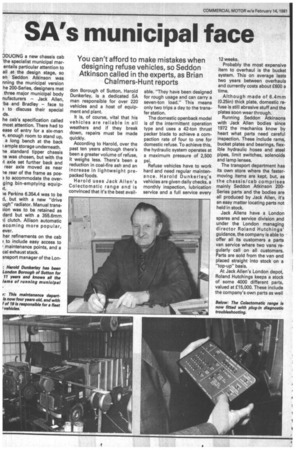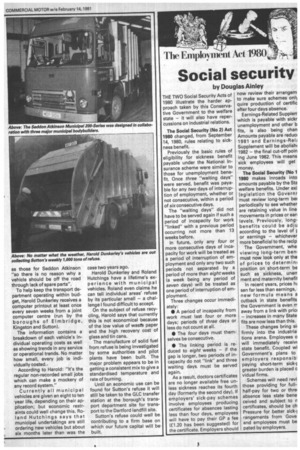SA's municipal face
Page 46

Page 47

If you've noticed an error in this article please click here to report it so we can fix it.
You can't afford to make mistakes when designing refuse vehicles, so Seddon Atkinson called in the experts, as Brian Chalmers-Hunt reports
DDUCING a new chassis cab the specialist municipal marentails particular attention to ail at the design stage, so en Seddon Atkinson was nning the municipal version he 200-Series, designers met three major municipal body nufacturers — Jack Allen, .ba and Bradley — face to to discuss their special ds.
he cab's specification called most attention. There had to ease of entry for a six-man fv, enough room to stand up, a long bench at the back lample storage underneath. le standard tipper chassis le was chosen, but with the it axle set further back and rear axle moved as near le rear of the frame as pos?. to accommodate the overging bin-emptying equipIt.
te Perkins 6.354.4 was to be d, but with a new "drive ugh" radiator. Manual trans;ion was to be retained as dard but with a 355.6mm 1) clutch. Allison automatic ecoming more popular, ever.
her refinements on the cab to include easy access to maintenance points, and a cal exhaust stack.
ansport manager of the Lon don Borough of Sutton, Harold Dunkerley, is a dedicated SA man responsible for over 220 vehicles and a host of equipment and plant.
It is, of course, vital that his vehicles are reliable in all weathers and if they break down, repairs must be made quickly.
According to Harold, over the past ten years although there's been a greater volume of refuse, it weighs less. There's been a reduction in coal-fire ash and an increase in lightweight prepacked foods.
Harold uses Jack Allen's Colectomatic range and is convinced that it's the best avail
able. "They have been designed for rough usage and can carry a seven-ton load." This means only two trips a day to the transfer station.
The domestic open back model is of the intermittent operation type and uses a 42-ton thrust packer blade to achieve a compaction rate of four to one for domestic refuse. To achieve this, the hydraulic system operates at a maximum pressure of 2,500 psi.
Refuse vehicles have to work hard and need regular maintenance. Harold Dunkerley.'s vehicles are given daily checks, a monthly inspection, lubrication service and a full service every 12 weeks.
Probably the most expensive item to overhaul is the bucket system. This on average lasts two years between overhauls and currently costs about £600 a time.
Although made of 6.4mm (0.251n) thick plate, domestic refuse is still abrasive stuff and the plates soon wear through.
Running Seddon Atkinsons with Jack Allen bodies since 1972 the mechanics know by heart what parts need careful inspection. These include rams, bucket plates and bearings, flexible hydraulic hoses and steel pipes, limit switches, solenoids and lamp lenses.
The transport department has its own store where the fastermoving items are kept, but, as the chassis/cab comprises mainly Seddon Atkinson 200Series parts and the bodies are all produced by Jack Allen, it's an easy matter locating parts not held in stock.
Jack Aliens have a London spares and service division and under the London managing director Roland Hutchings' guidance, the company is able to offer all its customers a parts van service where two vans regularly call on all customers. Parts are sold from the van and placed straight into stock on a "top-up" basis.
At Jack Allen's London depot, Roland Hutchings keeps a stock of some 4000 different parts, valued at £15,000. These include the company's own parts as well as those for Seddon Atkinson "so there is no reason why a vehicle should be off the road through lack of spare parts".
To help keep the transport department operating within budget, Harold Dunkerley receives a computer printout at least once every seven weeks from a joint computer centre (run by the boroughs of Elmbridge, Kingston and Sutton).
The information contains a breakdown of each vehicle's individual operating costs as well as showing trends in any service or operational trends. No matter how small, every job is individually costed..
According to Harold: "It's the regular non-recorded small jobs which can make a mockery of any record system."
Currently all municipal vehicles are given an eight to ten year life, depending on their application; but economic restraints could well change this. Roland Hutchings says that municipal undertakings are still ordering new vehicles but about six months later than was the case two years ago.
Harold Dunkerley and Roland Hutchings have a lifetime's experience with municipal vehicles. Roland even claims he can tell individual areas' refuse by its particular smell — a challenge I found difficult to accept.
On the subject of refuse recycling, Harold says that currently this is not economical because of the low value of wastt paper and the high recovery cost of glass and tin cans.
The manufacture of solid fuel from refuse is being investigated by some authorities and pilot plants have been built. The major problem appears to be in getting a consistent mix to give a standardised temperature and rate of burning.
Until an economic use can be found for Sutton's refuse it will still be taken to the GLC transfer station at the borough's transport department site for transport to the Dartford landfill site.
Sutton's refuse could well be contributing to a firm base on which our future capital will be built.








































































































